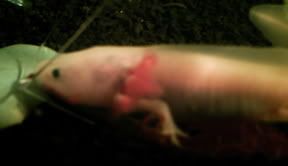
This is useful to know for holidays - but remember, the little fella will NOT be amused, and will be VERY hungry. If you can train someone to throw him in some food whilst you're away, that's a good idea. They can make sure everything is fine in there too.
As you might see in the "Toys" section, glass shrimp are good fun. Make sure you get Amato shrimp, and NOT Paleomontes or other species. Paleos are similar looking, but they have quite large claws, which hurt. Amato are small, fast little shrimp that do a great job of helping clean your tank.
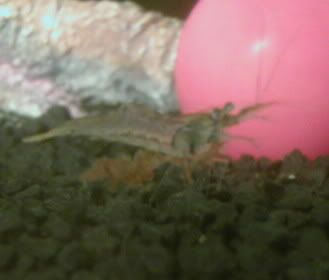
I seriously encourage the use of foodbowls - this stops them eating the substrate (gravel/sand etc) quite so much, and means they will be healthier - no gravel to block up their insides. It also means you can clean any rare leftovers up with complete ease!
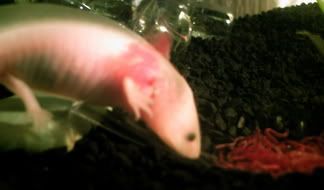
Well, except for the bits they chuck everywhere...
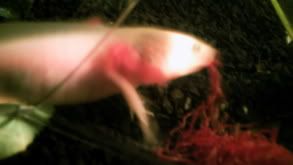
And here's why shrimp are so useful - they'll clean it up for you!
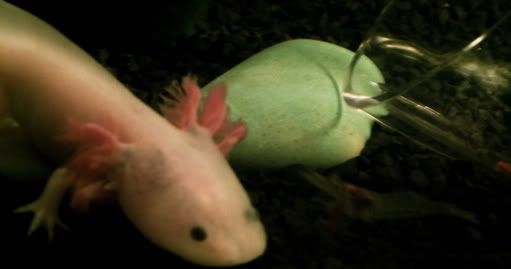
Here's a video of Spyyk cleaning up a destroyed dinner, putting that powerful hoovering mechanism we talked about in 101 to good use...
Variety in food can keep your axolotl highly amused! Staple diets are boring.
Would you want the same meal, day in, day out for the rest of your life?
Some people feed theirs live worms - but I've found this potentially risky due to parasites; however I've found a very good supplier. Rickeezee@Supanet.com supplies extraordinarily good Dendrobaena worms, between 50 - 100 (depending on size obv) in a tub for just £3.68 - that's including postage.
I go for these, because they're specially cultured, and so far less likely to have parasites. I keep mine in a small tank full of organic, pesticide/chemical free compost, and feed them anything I have going. They seem to like fishfood, and mash potato, but variety is best. Remember to purge your worms by dropping them in a bowl of water for 20 mins. Bear in mind some axolotl will often refuse to eat frozen food after enjoying the fight of something trying to escape, so try FREEZING the worm. Basically, it will kill the worm, (Sorry worm!) BUT - it will retain the awkward shape and "chase-ability" factor - you can encourage him/her to follow you around by dangling the worm in front of them. Keeping hold of one end when they snap at it also brings on a minor "tug-of-war" game!
Note: You may have to chop the worm up a bit to make it more managable to your pet. They can handle up to about a third to a half of their own bodylength in worm, but you may be surprised!
Another treat is human class meats.
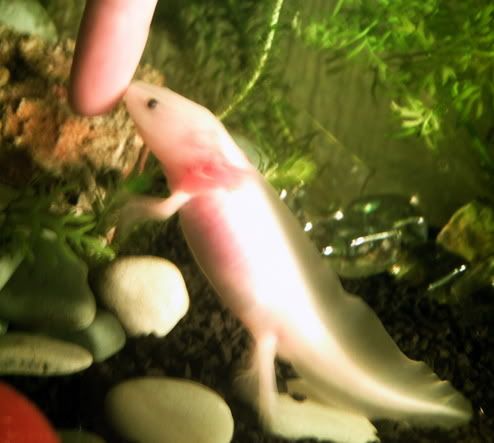
No, no! I didn't mean people should be eaten - I meant meats humans eat...
Now, these should be classed as rare treats, maybe once every two weeks and in small portions alongside normal meals. Make sure there is as little fat as possible on it, as axolotl can't digest some forms of fat very well.
Ham is acceptable if unsmoked and not any fancy cures. I soak mine to remove excess salts and chemicals - and to make it even more fun, I attach it to a vegetable clip - his very own tug-of-war game! Dangling a piece in is also great fun - they can have a good tug on the dinner with you.
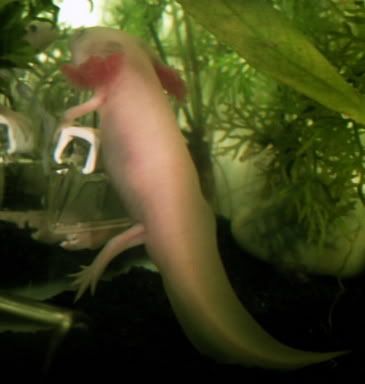
Hours of fun...
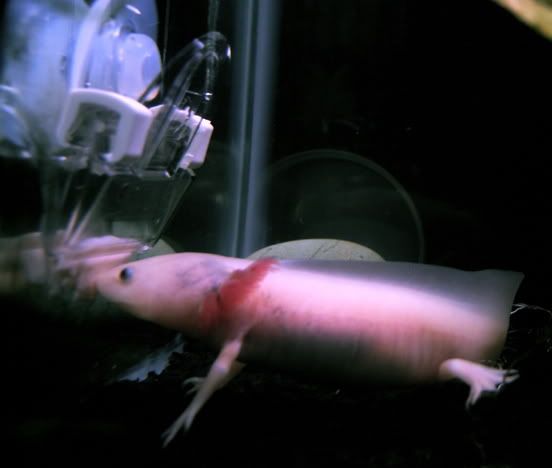
Some people feed theirs small strips of raw beefheart or liver. Keep it a RARE TREAT as it can be very fatty, but if you have a good butcher, this shouldn't be a problem. Others give axies nibbles of uncooked chicken, fish or lamb. Well, where are axolotl going to find roast chickens in the wild?!
Mealworms are sometimes given as a treat, but I don't encourage this for a couple of reasons: Mealworms have very large, powerful jaws which could potentially do serious damage to an axolotl - so you will need to crush those pincers before they get fed. Also, most amphibians have a problem digesting chitin - that tough shell on certain bugs. You'll be picking bits out of your filter for weeks! Eurgh.
Another treat is human class meats.

No, no! I didn't mean people should be eaten - I meant meats humans eat...
Now, these should be classed as rare treats, maybe once every two weeks and in small portions alongside normal meals. Make sure there is as little fat as possible on it, as axolotl can't digest some forms of fat very well.
Ham is acceptable if unsmoked and not any fancy cures. I soak mine to remove excess salts and chemicals - and to make it even more fun, I attach it to a vegetable clip - his very own tug-of-war game! Dangling a piece in is also great fun - they can have a good tug on the dinner with you.

Hours of fun...

Some people feed theirs small strips of raw beefheart or liver. Keep it a RARE TREAT as it can be very fatty, but if you have a good butcher, this shouldn't be a problem. Others give axies nibbles of uncooked chicken, fish or lamb. Well, where are axolotl going to find roast chickens in the wild?!
Mealworms are sometimes given as a treat, but I don't encourage this for a couple of reasons: Mealworms have very large, powerful jaws which could potentially do serious damage to an axolotl - so you will need to crush those pincers before they get fed. Also, most amphibians have a problem digesting chitin - that tough shell on certain bugs. You'll be picking bits out of your filter for weeks! Eurgh.
Another point applies to the live food problem - if it wiggles, they'll want it all the time.
Snails and slugs can make a tasty treat - make sure they are very small though - you don't want blockage problems, and remember to make sure they're from a chemical free environment.
Physa snails are absolutely ideal - they can absorb some of the calcium from the shell too. Baby Malaysian Trumpet Snails are sometimes acceptable. Just pick some out of your other tank, drop em in, and he/she will happily hunt them down. Strangely, we don't have a problem with live to frozen foods with snails... *shrugs* Don't worry - he didn't eat Gary here. Adult Malaysian Trumpet Snails are just too big and cone shaped to comfortably eat. Gary's still cleaning algae when he's not being sniffed at.

Some people give theirs feeder fish - there are a lot of reasons why I actively discourage this: Firstly, feeder fish are illegal in the UK. Second, as with most live foods, they can carry parasites and diseases, and the bones can sometimes cause problems. Not all Axies will eat live fish for some reason, which means the fish survives - and then nibbles on the axolotl. Not good.
Commercial fish pellets are actually pretty good as a staple diet, especially those formulated for salmon. Make for very good treats too. Mind out however - they are pretty expensive. *gulps*
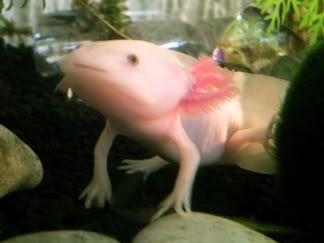
I find that soft fishing pellets for trout are a good snack. They don't fall apart too fast, and I can pick up a tub for about £2.99 at fishing stores. These can be good fun, and pretty tasty. He can spend AGES looking for them...
Where's it gone?!

Over here?

Turtle sticks - a good treat, but doesn't work for all axolotl. They don't sink very well and let's face it - these guys are lazy. They just can't be bothered swimming around the top to try and get it. Again, make sure they're well soaked, you don't want it dehydrating their insides :S
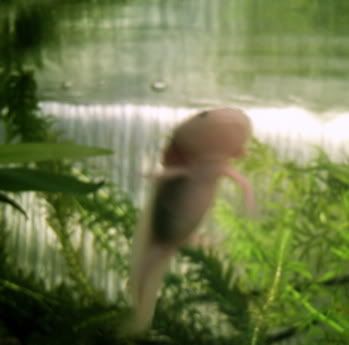
Dried tubifex worms are also a so-so treat, some will eat them, some won't - the flavour is somewhat lighter and the smells aren't as strong. Be very sure to squeeze all the air out of the cube, otherwise you'll end up with an annoyed 'Lotl floating around the top until he/she can burp. Don't worry - Spyyk was fine. He's mastered neutral buoyancy.
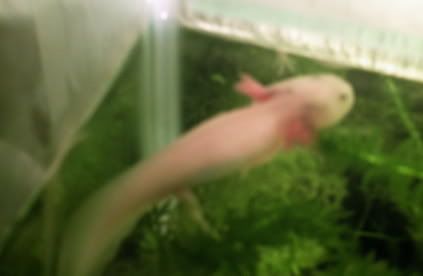
Freeze-dried crickets can make fun foods too - although they may be a little difficult to obtain. Don't forget to soak them, as they can hold a bit of air - as with tubifex cubes, you don't want a miffed fella drifting around.
If you have an axolotl that is underweight, then waxworms make a good food. One a day alongside normal feeding until they are back to full weight will balance their natural fat reserves. Easily obtained from fishing shops and reptile stores.
And there you have it, one happy 'Lotl. Scratch that - one TUBBY 'Lotl.
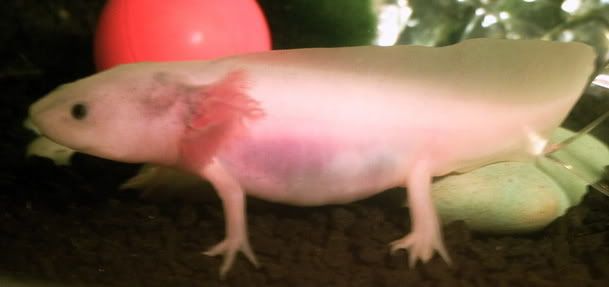
NEW!
Today I bought some frozen Lancefish (small baitfish - you can buy these easily in aquatic stores) to try out on Ye Olde GutBucket. Frozen Lancefish are specially bred for this purpose, and are treated against parasites and other nasties that are associated with live foods. Turns out they're a bit boney.
However, dedicated owner that I am, I accepted it back, laid it on Spyyk's plate (Spyyk has a plate especially for these sort of jobs) and filleted the fish. For those that don't know how to fillet - use a sharp knife to nick in slightly behind the head of the fish, on the side, into the meat. Carefully run the blade along the side of the spine towards the tail, and a nice sheet of fish will come off. Flip the fish over and repeat.
Et voila, lob in foodbowl, one happy lottle.
Et voila, lob in foodbowl, one happy lottle.
Peitsch made me laugh - he describes axolotl feeding as "a ferocious, violent assault that would knock down a building, if the salamander were the size of a great white shark."
No comments:
Post a Comment